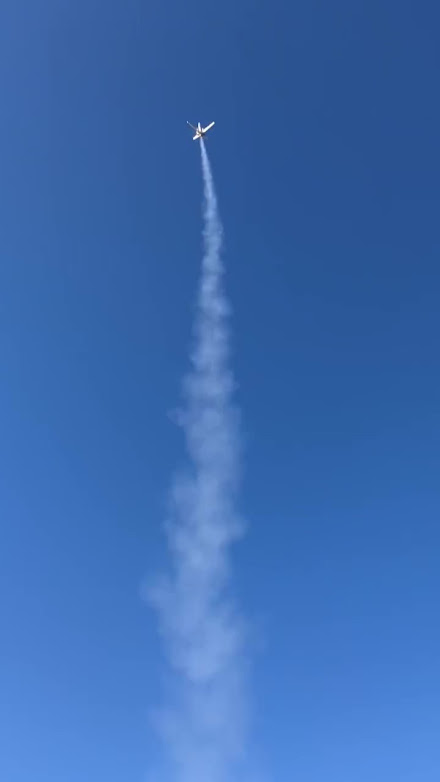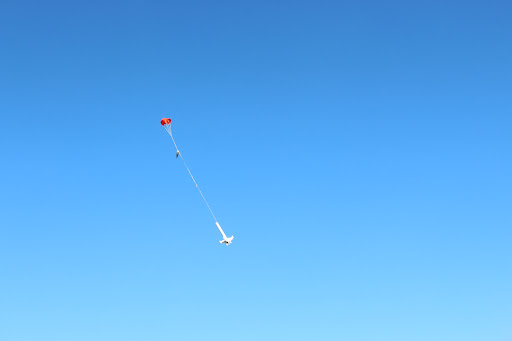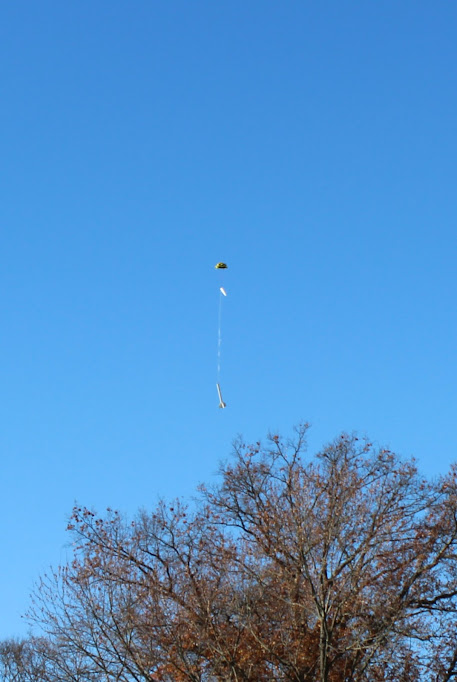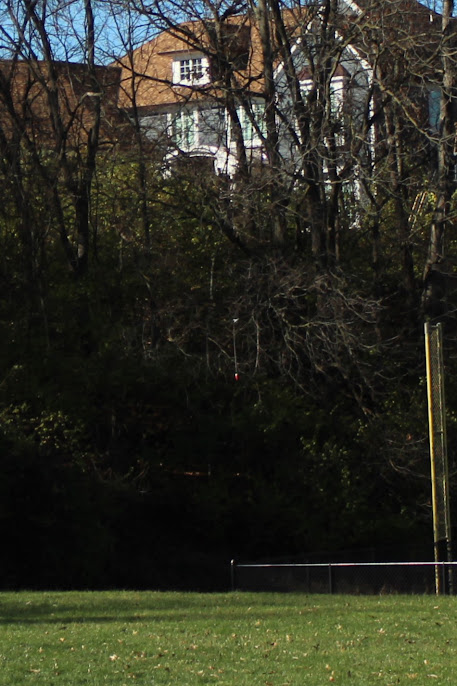Although I didn't know it at the time, I ended the November 4th launch with 2111 confirmed flights. When I got home and realized where things stood, I immediately began planning for the November 18th launch and trying to decide what rocket would fly as flight 2112.
2112.
That ceased to be just a number right around the time that I got into rocketry. I was a middle of the road student in high school. Bored. Disinterested. Probably depressed. I'm sure I wasn't alone. I took an art class when I was a sophomore, just because it provided a break from another talking head trying to convince me that I'd really need to know the inner workings of an earthworm. The art class was taught by a holdover from the 60's, a big part of the attraction the class held for me. Rock and roll blared from a cassette boombox, a rarity in those days, as we worked on our projects for an hour a day. One day we were making black light posters, and as such, the classroom lights were turned off for the hour and the black lights turned on. This was the atmosphere in which I discovered Rush.
When the music started it was kinda spacey, loopy synths that I only half paid attention to. I'm sure I came to a bit when the guitars, bass and drums joined in. It was when things really started galloping that I sat back in the dark, put down my paint brush, and just listened. The end of the album coincided with the end of the period, and Miss Haley wasn't at all happy to find that I'd produced a minimal blob on my posterboard. When I apologized to her and said I just got lost in the music, she pulled up a chair and quizzed me on it, genuinely thrilled to hear that all of my ideas about music had changed in the last 40 minutes.
2112.
I thought about what I wanted to fly for this milestone flight. I posted about my idea and someone mentioned that I should really consider a Canaroc design or a Black Brant. I immediately fixated on the Canaroc idea, and I had the perfect rocket for it, the Starfighter Scorpion. The only issue with this was that it was sitting in the basement hallway, dusty, half finished, and almost forgotten. The parts were scattered all over the basement. I went on safari and found the missing parts, a large wing, two small wings and a motor mount. I ordered the missing nose cone, then found the one I'd previously ordered on the day the new one arrived. I made an attempt to carve the nose cone as the instructions at YORP instructed, but I had no small files to do the detail work. Now I do, but it flew in roughed in shape. I had also planned to draw a red star on the wing, but every red pen in our house was dried up.
This would be an A8-3 flight, but had been a B6-4 before I came to the field. Yep, I wussed out, and it showed. Despite the somewhat ungainly appearance, the Starfighter Scorpion flight was impressively stable, and believe me, I saw the whole flight. The A8-3 only took it to around 200'. At ejection the chute deployed but didn't fill. In fact, it never filled, and the Scorpion chased its tail back to the pad.
I chose the Quest Bright Hawk as the second flight of the day. Yeah, I know, but I have a history with this very bird. I built it for a review in 2004, made all the flights here at B6-4 Field in an evening, then gave it to the son of one of my friends as payment for his recovery services on the night. He eventually lost interest and his Dad gave it back to me along with the rest of his collection. A few months back, I was loading the Bright Hawk and the glue on the motor mount failed after 19 years. On Friday night I treated it to a new motor mount, so it got the nod to get back in the air today. That's another one off of my "need to fly" spreadsheet.
The Bright Hawk got the first B6-4 flight of the day, and made the most of it, a gently arcing flight to short right, topping out around 350'. At ejection, it fell quickly with the parachute trailing behind for a while, but it eventually filled and brought it back to within fifteen feet of the pad. The cobwebs were blown out.
I have three Estes Hornets, the mini brute one, a pseudo-missile one, and the odd balsa nosed version of the Centuri Magnum Hornet, which is the one that flew third on this day. (I also have the Centuri version and an FSI version.) I bought it in one of the Estes holiday purges and it sat in my unbuilt kit stash until I had a hankering to build something one night. I wind up with a lot of projects like that.
The Hornet hadn't flown since 2015, which is why it got the call on this day. Clearing the list. Flying the new and seldom flown. It was loaded with a B6-4 because it should be. It was one of the better flights of the day, a slight arc out into right field to about 400', a perfect ejection at apogee, a nominal chute and a drift back to the infield. Flights like this are what made me call this place B6-4 Field.
I never got around to picking up the Semroc April Dancer during the time when it was an actual Semroc product. I recently made an offer on a built example on eBay and was surprised to have it accepted. The acceptance wasn't the surprise. It was the fact that eBay didn't appear to have notified me that the offer had been accepted, but just went ahead with the transaction. Lucky for me it was something that I wanted. When it arrived, I immediately replaced a fin that had been broken previously and repaired, painted the rocket, then left it behind when I went to the beanfield launch. DOH!
The A.D. took the same flight path as the Hornet, out toward right field to 400' with ejection as it tipped over. Instead of the gentle trip back toward the infield via the parachute, the A.D. was a parawad victim, and as a result, landed hard in right field near the line. Luckily, we had rain on Friday, so the outfield was a bit sodden. The A.D. stuck the landing on the new fin.
It was about this time that I pulled the Semroc Astro-1 from the tote. I had recently had a shop accident where I cut a corner too tight and lost my balance. The Astro-1 was in a box with several other recently flown rockets and when I tried to correct my imbalance, I wound up stepping in the box. The Astro-1, Semroc Astron and Sky Hook 2 were all damaged, with the Astro-1 and Sky Hook 2 being the worst. I cut new fins for the Astro-1 and Astron earlier in the week, so they were in place, but not painted when I packed for the field. Unfortunately, the Astro-1 needed two new fins instead of one, which I found when I pulled it out, so it didn't make a flight today.
Instead, I decided on the Centuri Design Contest X-Wing Fighter, a rocket that I hadn't flown since 2012. This long-suffering project has lain pretty much dormant since 2012 when a C6 CATO in the corn welcomed it into the world of flight. I kinda lost interest except for repairing it for a second flight here at B6-4 Field. After this flight I'm once again interested in finishing it.
The flight was a fourth straight on a B6-4 and followed the flight path du jour, arcing out toward right field. It reached 350' before tipping over, ejecting, and recovering on the infield at shortstop. All in all, a pretty impressive flight, and one that has me thinking about finally finishing the project.
My newly built Semroc IRIS was up next. This one was a tweener. I had this one loaded with an A8-3 at one point in the prep process, but I eventually swapped it out for a B6-4. Once I was at the field, I wondered if the swap had been a mistake, but I pressed on.
The B6-4 in the IRIS was the one that had originally been loaded in the Starfighter Scorpion. I'm pretty sure things would still have been impressive on both counts if I'd have left them as they stood, but since both were successful flights, I'm not inclined to complain. The IRIS chose the company flight path, straight out toward right field to 400'. It ejected as it was facing down and fell a long way before the chute eventually filled. Well, partially filled. As a result of the less than optimal recovery, the recovery happened in right field instead of on the infield. I regarded that as recovery area B.
The Semroc Astron was a freebie that Carl included with one of my orders. It was another of the rockets that got stepped on in my failed shop ballet last year. I was able to find all of the pieces and glue them together, but in the end I just decided to cut a new one.
I knew from past experience that an A8-3 flight here in the Astron was more than enough for an impressive flight, 300'+ with ease. This flight was no exception. I wrote down 320', but I should have added -ish. Flight path was as expected, out into right field, but the streamer decided against streaming and the recovery was at second base. I was trying a new camera/launcher technique today, using my Canon Rebel set on burst mode. This is all I have of this flight. Clearly the old dog isn't great a new tricks.
The Estes Scamp wasn't on my list of rockets to fly on this day, but something about it spoke to me when I was gathering kits for the launch. I think it was the fluorescent yellow paint.
First of all, I'm shocked at how washed out the yellow paint looks in this pic. Even though it is clear coated, it pops in person. This would be an A8-3 flight, as would be the two that followed. This would only be flight #3 on this version, which surprised me. Seems like I flew it more, but I could be remembering flights of v.1. This flight was off script for the afternoon, a slight bend out toward center, then a slow drift back toward the infield that ended at deep second. Altitude was short of 300', I wrote down 275', but I also wrote down that it was the best flight of the day.
Flight #9 would be another recently repaired bird, the Bo-Mar Ajax. I didn't step on this one. It had an unfortunate infield landing when the infield was fairly well baked. The impact didn't look like something that could have broken a fin, but it was hanging in two pieces when I picked it up.
This was another flight that I wound up getting nothing but smoke for the launch shot. The Rebel just isn't fast enough to get everything unless you time it perfectly. I didn't time it perfectly. After having most of my flights follow the path out over right field, the Scamp showed a definite lean toward center field. The Ajax didn't make any pretenses about heading toward right on an A8-3. It took off way left and behind me. My first thought was school roof, but I was happy to be proven wrong. It topped out around 400' and began streaming toward Woodfill Avenue after ejection. Luckily the trees are not as expansive there these days and it was able to recover without incident about 3/4 of the way up the hill.
The last A8-3 flight of the day would be the BT-20 Cherokee A. I have quite a few Cherokee variants, Micromax through E. The A version hadn't flown since 2015, so it got the nod today.
Despite the rod being angled the same way, the Cherokee A flight was a polar opposite of the Kopter Hawk. Altitude was similar, around 400', but the flight path was back into right field. Way into right field. It ejected over the trees behind the Birdcage and looked like it was about to become another of my year-round holiday ornaments but blew back toward the Birdcage outfield. There was a family doing a softball workout, so I figured there was a chance I could talk them into returning it to me if it landed in the outfield, but that became moot when it breezed all the way back to B6-4 Field, landing on the right field foul line.
That was flight #10, a successful small field day by anyone's standards, and I could have packed up and left right then. I never gave it a thought. I still had a rocket loaded and I'd made sure I had the green plug required to keep the igniter in place. The Semroc Firefly was loaded with an eye toward flying in the cornfield, A10-0T to 1/2A3-4T. Not a huge altitude load, but not really a B6-4 Field load either. There was no reason for me to make this flight.
The Firefly had lain dormant for a number of years because it was a serial victim of hangar rash. In fact, one of the sustainer fins had snapped off when I was trying to seat the motor in the adapter only the day before. I glued it back and will replace it when it eventually breaks again, but that wouldn't be today. The flight was excellent, boosting straight and staging around 100-150'. The booster began coming back to my left, flipping wildly. I didn't get a shot of the recovering booster because my attention was diverted by the sustainer, which had ignited after windcocking and taken a flight path toward the Birdcage outfield and the trees behind the fence. It ejected over the left field foul line on the birdcage field, then began drifting back toward the right field line at B6-4 Field. It landed near the line undamaged. With the sustainer safe, I began looking for the booster, which, being gloss black, should have been easily found. Fifteen minutes later it was. I walked the whole outfield from short center to deep left-center. I found it fifteen feet from the pad. It really wasn't that noticeable after all.
So, I learned a few things. Two stage mini rockets should likely be saved for the cornfield. Gloss black blends with everything. A8-3s should be saved for smaller rockets on this field. (Okay, that wasn't a lesson. I already knew that, but I just had to try it out.)
The lineup. All present, accounted for, and best of all, undamaged.







.JPG)






.JPG)



















Hi, Bill,
ReplyDeleteGreat launch report and pics !!! Very cool selection of rockets, new and old.
Thanks, Ed. I'm whacking away at the birds that haven't had a flight in more than five years. Since 2024 is coming, the 2018 birds are next. Not sure how many chances to fly I'll have before then.
ReplyDelete